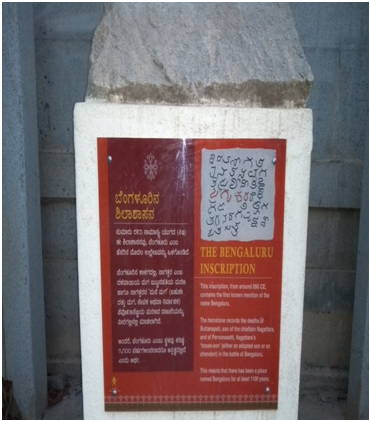The name ''Bangalore'' represents an anglicized version of the Kannada language name, ''Bengaluru''.
There are many competing popular theories to the name Bengaluru!
Suresha Devadiga teacher at BVM Global Bengaluru conducted his own research on this topic.
Read on to discover the various theories behind the name ''Bengaluru'' and finally the conclusion of Suresha Devadiga.
Bangalore the capital city of Karnataka was renamed to ''Bengaluru'' on first November 2014. The official language spoken in this region is Kannada. It is also called as Silicon city, Garden city and so on. Bengaluru is not only a modern city but also has a very rich and long period of history.
The historical term ''Bengaluru'' has existed for a long time however the British anglicized the name to Bangalore for easy pronunciation.
As per current chroniclers, in the year 1537 Kempegowda, a feudatory ruler under Vijayanagara Empire was the founder of Bengaluru who built a mud fort which is still known as 'Bengaluru/Bangalore fort'
However history of Bengaluru begins with dynasties like Gangas, Cholas and Hoysalas who ruled in this region for a long period.
The Gangas ruled Gangavadi from Kolar starting CE. 350 and later shifted their capital to Talakadu.
The various theories & claims behind the name ''Bengaluru''
a) Bengaluru was also called as ''Kalyana Nagara'' in one of the inscriptions placed in the Nagareshwara temple in the Nagarthapete (Bengaluru town area). In the sixth line of the inscription it is mentioned as ''Kalyani nagarivasa nagarasthe mahajanai sreemakaha kuladevathasya'' as per Dr. MG Manjunath of Benagaluru Darshana.
Location : https://tinyurl.com/Sri-Nagareshwara-Swamy-Temple
b) Dr. Suryanath Kamath said that ''In and around Benagaluru there were abundant of Raktha Honnemara'' that was called in old Kannada as Benga tree so it became Benga + uru (village) = Benagaluru.
c) Someshwara temple in Madiwala has a Tamil stone inscription (C.E 1247) and the name ''Vengaluru'' is mentioned in it . The Tamil letter 'Va' was used as ''Ba'' in Old Kannada later and one theory suggests that the name might have changed to Bengaluru.
https://en.wikipedia.org/wiki/Old_Madiwala_Someshwara_Temple,_Bangalore
Location : https://tinyurl.com/Sri-Someshwara-Swamy-Temple
d) Professor HK Rajegowda says that one of the hero stones ''Veera kallu'' has the name ''Bengavaluru''. As per this claim, this veera kallu was much before the Bengaluru inscription of CE 890, and that's how the name became ''Bengaluru''. However there is no evidence of the 'veera kallu'.
e) Some scholars suggest that, ''Veeraballala II'' a 12th century Hoysala king once came to this region while on a hunting expedition and lost his way in the forest. Tired & hungry he came across a poor old woman who served him boiled beans to eat. The grateful king named the place ''benda-kaal-uru'' (literally town of boiled beans in Kannada) which eventually evolved into Bengaluru. However there is no evidence to back this most popular & famous claim behind the name.
f) Others scholars also argue that, in this region abundant of pebbles are found that are called ''Benachu kallu'' in Kannada. Later this term Benachu kallu + uru became Bengaluru. Similarly this theory lacks evidentiary support to the claim.
g) The earliest reference to the name Bengaluru, comes from a stone inscription belonging to the Ganga dynasty, dating back to 890 CE.
The 1000 year old stone inscription in the Parvathi Nageshwara Temple in Begur (Bengaluru), carved on a ''vira kallu'' (literally hero stone, a rock edict extolling the virtues of a warrior) in halle Kannada (old Kannada) of the 9th Century has an epigraph which refers to a Bengaluru war in 890 CE in which Buttanachetty, a servant of Nagattara, died. This has been recorded by historian R. Narasimhachar in his ''Epigraphia of Carnatica'' (Vol. 10 supplementary). The stone inscription found near Begur reveals, that the district was part of the Ganga Kingdom ruled from Gangavadi until 1024 C.E and was known as 'Benga-val-oru', the City of Guards in old Kannada. Bengaluru inscription of 890 C.E has the information ''Nagatharana Manemagam Buttanashetty Bengalura kalagal sattham''. This rock inscription evidence talks about the Bengaluru war and we learn that that Bengaluru is over a 1000 year old city.
https://en.wikipedia.org/wiki/Nageshvara_Temple,_Begur
Location : https://tinyurl.com/Begur-Parvathi-Nageshwara-Temp
The inscription in the Begur Parvathi Nageshwara Temple – Bengaluru

My conclusion based on research, is that the origin of the term Bengaluru supported by the best available evidence is the Bengaluru Shasana (stone inscription) in the Naga Natheshwara temple located in Beguru. Therefore I believe that the name ''Bengaluru'' was derived from the old Kannada word meaning ''City of Guards'' and is over a 1000 years old.
Suresha Devadiga
Reference :
1. Narasimhachar.R[ed] - Ephigraphia of carnatica , vol-10, Supplementary,
2. Prof. Nagaraj .M.G Samshodhana - Thenegalu, PP-382-386
3. Prof . Jamuna .M.[C.ed] Dr. Manjunath M.G. [ed] - Yalahanka Nadaprabhugala Shasana Samputa Prasaranga, BUB, 2006.
4. Dr. Rajanna .G - Kempegowda Vamshavali , Minor Project , NKCH & SS, BUB, 2018
5. Prof. Krishnaiah and Dr. Vijaya [ ed] - Bengaluru Darshana, Udayabanu Kalasangha, Bengaluru, 2016. PP-8.9
